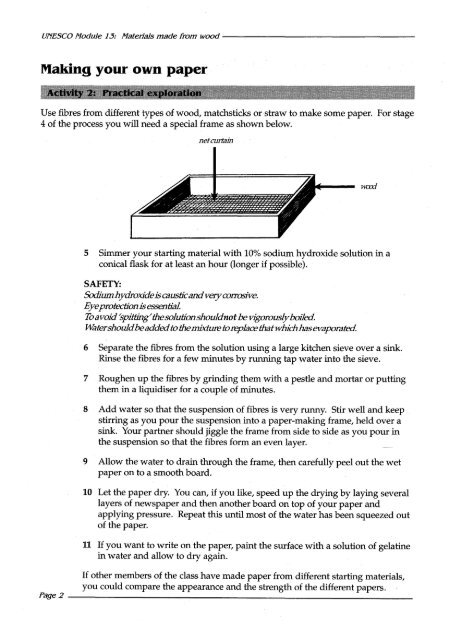UNESCO resource kit - science and technology educa...
UNESCO resource kit - science and technology educa...
UNESCO resource kit - science and technology educa...
You also want an ePaper? Increase the reach of your titles
YUMPU automatically turns print PDFs into web optimized ePapers that Google loves.
<strong>UNESCO</strong> Module 13: Materials made from wood -------------------<br />
Making your own paper<br />
Use fibres from different types of wood, matchsticks orstrawto make some paper. For stage<br />
4 of the process you will need a special frame as shown below.<br />
net curtain<br />
5 Simmer your starting material with 10% sodium hydroxide solution in a<br />
conical flask for at least an hour (longer if possible).<br />
SAFETY:<br />
Sodium hydroxide is caustic <strong>and</strong> very corrosive.<br />
Eye protection is essential.<br />
Toavoid 'spitting' thesolutionshouldnot be vigorouslyboiled.<br />
Watershould be added to the mixture to replace that which has evaporated.<br />
6 Separate the fibres from the solution using a large <strong>kit</strong>chen sieve over a sink.<br />
Rinse the fibres for a few minutes by running tap water into the sieve.<br />
7 Roughen up the fibres by grinding them with a pestle <strong>and</strong> mortar or putting<br />
them in a liquidiser for a couple of minutes.<br />
8 Add water so that the suspension of fibres is very runny. Stir well <strong>and</strong> keep<br />
stirring as you pour the suspension into a paper-making frame, held over a<br />
sink. Your partner should jiggle the frame from side to side as you pour in<br />
the suspension so that the fibres form an even layer.<br />
9 Allow the water to drain through the frame, then carefully peel out the wet<br />
paper on to a smooth board.<br />
10 Let the paper dry. You can, if you like, speed up the drying by laying several<br />
layers of newspaper <strong>and</strong> then another board on top of your paper <strong>and</strong><br />
applying pressure. Repeat this until most of the water has been squeezed out<br />
of the paper.<br />
11 If you want to write on the paper, paint the surface with a solution of gelatine<br />
in water <strong>and</strong> allow to dry again.<br />
If other members of the class have made paper from different starting materials,<br />
you could compare the appearance <strong>and</strong> the strength of the different papers.<br />
Page 2 -- _<br />
wax!

















